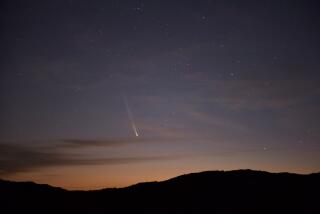Good Vantage Point : Pioneer 12 Is U.S. Eye on Halley’s
- Share via
The United States is the only country with a major space program that is not sending up a spacecraft for a closer view of Halley’s Comet.
Through a clever bit of juggling, however, American scientists have enabled the United States to become the only country to use a spacecraft to study the comet during its most active phase.
Scientists at Ames Research Center in Mountain View have embarked on a 10-week program to study Halley through Pioneer 12, which was launched in 1978 and is orbiting Venus where it is exploring that planet’s atmosphere.
The location of Pioneer 12 and the peculiarities of this visit by Halley to the inner solar system provide a unique opportunity to study the fabled comet.
Solar Winds Fan Radiation
When comets are far from the sun, they are dull chunks of ice and dust. But as they approach the sun, solar winds blow off particles and gases, creating the tail, and energize the nucleus, causing it to radiate so much that even small comets can be seen from Earth, millions of miles away. Thus, comets are in their most active phase when they make their closest approach to the sun.
In Halley’s case, the closest approach during this “apparition,” as astronomers call it, will be Feb. 9 while the comet is on the other side of the sun. During that period it will not be visible from anywhere on Earth.
But as it happens, Venus and its artificial satellite, Pioneer 12, also will be on the opposite side of the sun, uniquely positioned to observe the comet during that active stage. Although Halley will be about 27 million miles from the spacecraft, it will be within 55 million miles of the sun. By the time the comet is again visible from Earth in mid-February, it will be millions of miles farther from the sun. When it is encountered by five space probes (two Japanese, two Soviet and one European) in early March, it will be more than 90 million miles from the sun.
The decision to divert Pioneer 12 from its studies of Venus and focus on Halley was reached some time ago because “it became obvious that Pioneer would be in a great position to observe the comet,” said Peter Waller, an Ames spokesman.
Continue Through March 6
Pioneer’s cometary mission began the day after Christmas and will continue through March 6, with one interruption from Jan. 4 through Feb. 3, when communications with the spacecraft will be blocked by the sun.
The spacecraft will observe the comet through an ultraviolet spectrometer--a telescope that sees ultraviolet rather than visible light--developed by the University of Colorado. Most atoms emit ultraviolet light when radiated by the sun, so the images from Halley during its closest approach should be spectacular, according to scientists working on the project.
For one thing, an ultraviolet Halley will be about 20 times larger than a visible Halley because of the giant hydrogen cloud that surrounds the nucleus of the comet. Most of the tail will not be visible to the ultraviolet scope, however, so the comet should look somewhat like a giant egg, Waller said.
The images the spectrometer will produce will be a bit of a technological marvel. Since the device sees only a narrow band of the sky, it will have to scan the comet 20,000 times, producing narrow strips of images that will be combined for the final product. The spacecraft will have to be tipped slightly for each strip, requiring ground controllers to fire its small thruster rockets about 1,000 times. About half of the craft’s remaining fuel will be used up.
The wavelengths and intensities of the ultraviolet light emitted by the comet will also help scientists identify the substances that make up the comet.






